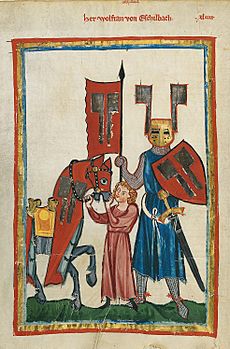Wolfram von Eschenbach facts for kids

Wolfram von Eschenbach (born around 1160-1180 – died around 1220) was a famous German knight, poet, and composer. He is known as one of the greatest epic poets of the Middle Ages in Germany. He also wrote lyric poetry, which means he wrote songs, often about love.
Contents
Life of Wolfram
We don't know much about Wolfram's life because there are no official documents that mention him. Everything we know comes from his own writings. In his most famous work, Parzival, he mentions "we Bavarians," which suggests he was from Bavaria. Today, a town called Wolframs-Eschenbach is believed to be his birthplace, but this is just a guess based on clues in his poems.
Wolfram probably worked for different powerful people, like Hermann I of Thuringia. This suggests he traveled to various courts. He often wrote about being poor, so he likely wasn't a wealthy man.
Interestingly, Wolfram said in Parzival that he couldn't read or write. Many experts believe this might be true, meaning he probably dictated his poems to someone else who wrote them down. He knew some French, but maybe not perfectly, as some of his names for characters sound a bit mixed up.
Wolfram's Works
Wolfram von Eschenbach wrote several important works. His most famous one is Parzival, but he also wrote other stories and songs.
The Story of Parzival
Wolfram is most famous for his epic poem Parzival. Many people think it's one of the best German Arthurian romances. This long poem tells the story of the Holy Grail, which Wolfram described as a special gemstone.
His story was based on an unfinished poem by a French writer named Chrétien de Troyes. However, Wolfram claimed his version came from a different poet from France named Kyot.
Titurel and Willehalm
Wolfram also wrote two other long stories: Titurel and Willehalm. Both of these were written after Parzival.
- Titurel: This poem is not complete and only exists in two parts. It tells the story of two lovers, Schionatulander and Sigune, who were also mentioned in Parzival. One part describes how they fell in love. The other part is about a mysterious dog with a story written on its leash. Sigune wants to read the story, but the dog runs away. Schionatulander goes after it and, as we know from Parzival, he sadly dies trying to find it.
- Willehalm: This is another unfinished poem, but it was very popular and many copies still exist. It's about wars between Christians and Saracens (a term used for Muslims in the Middle Ages). The hero, Willehalm, takes a Saracen princess, who then becomes a Christian and marries him. Her father, the Saracen king, raises an army to get her back. The poem shows many features of medieval stories, like brave knights and big battles.
Wolfram's Songs
Wolfram wrote nine songs that are still known today. Five of these are "dawn-songs." Dawn-songs are about a knight who spends the night with his lady love and then has to leave secretly at dawn. Usually, the lady or a watchman wakes the knight up. We don't have the music for these songs anymore, but they are considered masterpieces of Minnesang (medieval German love poetry).
Wolfram's Influence
Wolfram's works were very popular in the centuries after he lived. There are 84 surviving copies of Parzival and 78 copies of Willehalm, which shows how much people enjoyed them. Other poets even wrote continuations of his unfinished works.
People rediscovered Wolfram's work much later. In 1753, a scholar published a translation of Parzival. Later, the famous composer Richard Wagner used Parzival as the main source for his opera, also called Parsifal. Wolfram himself even appears as a character in another one of Wagner's operas, Tannhäuser.
Images for kids
See also
 In Spanish: Wolfram von Eschenbach para niños
In Spanish: Wolfram von Eschenbach para niños




